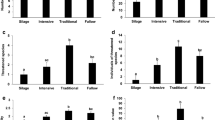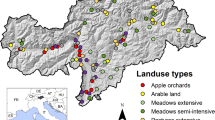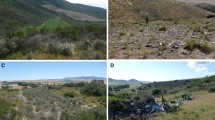Abstract
Large-scale deforestation in the tropics, triggered by logging and subsequent agricultural monoculture has a significant adverse impact on biodiversity due to habitat degradation. Here, we measured the diversity of butterfly species in three agricultural landscapes, agroforestry orchards, oil palm, and rubber tree plantations. Butterfly species were counted at 127 sampling points over the course of a year using the point count method. We found that agroforestry orchards supported a greater number of butterfly species (74 species) compared to rubber tree (61 species) and oil palm plantations (54 species) which were dominated by generalist (73%) followed by forest specialists (27%). We found no significant difference of butterfly species composition between agroforestry orchards and rubber tree plantation, with both habitats associated with more butterfly species compared to oil palm plantations. This indicates butterflies were able to persist better in certain agricultural landscapes. GLMMs suggested that tree height, undergrowth coverage and height, and elevation determined butterfly diversity. Butterfly species richness was also influenced by season and landscape-level variables such as proximity to forest, mean NDVI, and habitat. Understanding the factors that contributed to butterfly species richness in an agroecosystem, stakeholders should consider management practices to improve biodiversity conservation such as ground vegetation management and retaining adjacent forest areas to enhance butterfly species richness. Furthermore, our findings suggest that agroforestry system should be considered to enhance biodiversity in agricultural landscapes.






Similar content being viewed by others
Data availability
Data generated from this study will be provided upon reasonable request by the corresponding author.
References
Abdullah SA (2011) The characteristics of the cultural landscape in malaysia: concept and perspective. In: Hong SK., Kim JE., Wu J., Nakagoshi N (Eds) Landscape ecology in Asian cultures. Ecological research monographs. Springer, Tokyo. https://doi.org/10.1007/978-4-431-87799-8_4
Acharya BK, Vijayan L (2015) Butterfly diversity along the elevation gradient of Eastern Himalaya, India. Ecol Res 30:909–919. https://doi.org/10.1007/s11284-015-1292-0
Ahrends A, Hollingsworth PM, Ziegler AD, Fox JM, Chen H, Su Y, Xu J (2015) Current trends of rubber plantation expansion may threaten biodiversity and livelihoods. Glob Environ Chang 34:48–58
Alroy J (2017) Effects of habitat disturbance on tropical forest biodiversity. Proc Natl Acad Sci 114:6056–6061
Ashraf M, Zulkifli R, Sanusi R, Tohiran KA, Terhem R, Moslim R et al (2018) Alley-cropping system can boost arthropod biodiversity and ecosystem functions in oil palm plantations. Agr Ecosyst Environ 260:19–26
Ashraf M, Sanusi R, Zulkifli R, Tohiran KA, Moslim R, Ashton-Butt A, Azhar B (2019) Alley-cropping system increases vegetation heterogeneity and moderates extreme microclimates in oil palm plantations. Agric for Meteorol 276:107632
Asmah S, Ghazali A, Syafiq M, Yahya MS et al (2017) Effects of polyculture and monoculture farming in oil palm smallholdings on tropical fruit-feeding butterfly diversity. Agric for Entomol 19:70–80
Athukorala P-C, Loke W-H (2009) Agricultural incentives in Malaysia: trends, patterns and policy implications. Malays J Econ Stud 46(2):151–173
Azhar B, Saadun N, Puan CL, Kamarudin N, Aziz N, Nurhidayu S, Fischer J (2015a) Promoting landscape heterogeneity to improve the biodiversity benefits of certified palm oil production: evidence from Peninsular Malaysia. Glob Ecol Conserv 3:553–561. https://doi.org/10.1016/j.gecco.2015.02.009
Azhar B, Puan CL, Aziz N et al (2015b) Effects of in situ habitat quality and landscape characteristics in the oil palm agricultural matrix on tropical understory birds, fruit bats and butterflies. Biodivers Conserv 24:3125–3144. https://doi.org/10.1007/s10531-015-1005-6
Azhar B, Saadun N, Prideaux M, Lindenmayer DB (2017) The global palm oil sector must change to save biodiversity and improve food security in the tropics. J Environ Manage 203:457−466
Azhar B, Nobilly F, Lechner AM, Tohiran KA, Maxwell T et al (2021) Mitigating the risks of indirect land use change (ILUC) related deforestation from industrial palm oil expansion by sharing land access with displaced crop and cattle farmers. Land Use Policy 107:105498. https://doi.org/10.1016/j.landusepol.2021.105498
Bailey SA, Horner-Devine MC, Luck G, Moore LA, Carney KM, Anderson S et al (2004) Primary productivity and species richness: relationships among functional guilds, residency groups and vagility classes at multiple spatial scales. Ecography 27(2):207–217
Barnes DE, Chan LG (1990) Common weeds of Malaysia and their control. Ancom Berhad
Barnes AD, Jochum M, Mumme S, Haneda NF, Farajallah A, Widarto TH, Brose U (2014) Consequences of tropical land use for multitrophic biodiversity and ecosystem functioning. Nat Commun 5:5351. https://doi.org/10.1038/ncomms6351
Benedick H, Hill K, Mustaffa N, Chey VK, Maryati M, Searle B, Schilthuizen M, Hamer KC (2006) Impacts of rain forest fragmentation on butterflies in northern Borneo: species richness, turnover and the value of small fragments. J Appl Ecol 43:967–977. https://doi.org/10.1111/j.1365-2664.2006.01209.x
Bhagwat SA, Willis KJ, Birks HJB, Whittaker RJ (2008) Agroforestry: a refuge for tropical biodiversity? Trends Ecol Evol 23:261–267
Brown KS, Freitas AVL (2003) Butterfly communities of urban forest fragments in Campinas, São Paulo, Brazil: structure, instability, environmental correlates, and conservation. J Insect Conserv 6:217–231
Burghardt KT, Tallamy DW, Gregory SW (2009) Impact of native plants on bird and butterfly biodiversity in suburban landscapes. Conserv Biol 23(1):219–224
Checa MF, Donoso DA, Rodriguez J, Levy E, Warren A, Willmott K (2019) Combining sampling techniques aids monitoring of tropical butterflies. Insect Conserv Diversity 12(4):362–372
Chao A, Ma KH, Hsieh TC (2016) User’s guide for iNEXT online: Software for interpolation and Extrapolation of species diversity. Code 30043(September):1–14
Clarke KR, Gorley RN (2006) User Manual/Tutorial. PRIMER‐E Ltd, U.K
Cleary DFR (2004) Assessing the use of butterflies as indicators of logging in Borneo at three taxonomic levels. J Econ Entomol 97(2):429–435
Collinge SK, Prudic KL, Oliver JC (2003) Effects of local habitat characteristics and landscape context on grassland butterfly diversity. Conserv Biol 1:178–187
Colwell RK, Chao A, Gotelli NJ, Lin SY, Mao CX, Chazdon RL, Longino JT (2012) Models and estimators linking individual-based and sample-based rarefaction, extrapolation and comparison of assemblages. J Plant Ecol 5(1):3–21
Corbet AS, Pendlebury HM (1992) The butterflies of the Malay Peninsula, 4th revised edition by Eliot JN. Malayan Nature Society, Kuala Lumpur
Corbet AS, Pendlebury HM (2020) The Butterflies of the Malay Peninsula, 5th edition, revised by George van der Poorten & Nancy van der Poorten. Malayan Nature Society, Kuala Lumpur
Díaz S, Fargione J, Chapin FS III, Tilman D (2006) Biodiversity loss threatens human well-being. PLoS Biol 4(8):e277. https://doi.org/10.1371/journal.pbio.0040277
Denan N, Wan Zaki WM, Norhisham AR, Sanusi R et al (2019) Predation of potential insect pests in oil palm plantations, rubber tree plantations, and fruit orchards. Ecol Evol. https://doi.org/10.1002/ece3.5856
Department of Statistics Malaysia (DOSM) (2019) Key data-fruit crop statistics Malaysia 2019. https://www.dosm.gov.my. Accessed 20 July 2020
De Vries PJ, Walla TR (2001) Species diversity and community structure in neotropical fruit-feeding butterflies. Biol J Lin Soc 74(1):1–15
Dong J, Xiao X, Chen B, Torbick N, Zhang G, Biradar C, Jin C (2013) Mapping deciduous rubber plantations through integration of PALSAR and multi-temporal Landsat imagery. Remote Sens Environ 134:392–402
Dormann CF, Elith J, Bacher S et al (2013) Collinearity: a review of methods to deal with it and a simulation study evaluating their performance. Ecography 36:27–46
Elba B, Suárez SA, Lenardis AE, Poggio SL (2014) Intercropping sunflower and soybean in intensive farming systems: evaluating yield advantage and effect on weed and insect assemblages. NJAS-Wageningen J Life Sci 70:47–52
Elings J, Kirimbo G, Li X, Mandal P (2017) Enhancing biodiversity in traditional fruit orchards. Ecological Consultancy Bureau. Wageningen University, Red Apple
Ekroos J, Kuussaari M, Tiainen J, Heliölä J, Seimola T, Helenius J (2013) Correlations in species richness between taxa depend on habitat, scale and landscape context. Ecol Ind 34:528–535. https://doi.org/10.1016/j.ecolind.2013.06.015
Ewers RM, Scharlemann JPW, Balmford A, Green RE (2009) Do increases in agricultural yield spare land for nature? Glob Chang Biol 15:1716–1726
Fee CG, Tui LC, Bin CS, Hoy CK (2017) Pictorial guide to common weeds of plantations and their control (No. L-0987), 2nd ed. Agricultural Crop Trust, ACT, Bonn
Fitzherbert EB, Struebig MJ, Morel A, Danielsen F, Brühl CA, Donald PF, Phalan B (2008) How will oil palm expansion affect biodiversity? Trends Ecol Evol 23(10):538–545
Ghazali A, Asmah S, Syafiq M et al (2016) Effects of monoculture and polyculture farming in oil palm smallholdings on terrestrial arthropod diversity. J Asia-Pacific Entomol 19:415–421
Giam X (2017) Global biodiversity loss from tropical deforestation. Proc Natl Acad Sci USA 114:5775–5777. https://doi.org/10.1073/pnas.1706264114
Goh KJ (2005) Fertilizer recommendation systems for oil palm: estimating the fertilizer rates. In: Proceedings of MOSTA best practices workshops-agronomy and crop management. Malaysian Oil Scientists’ and Technologists’ Association, pp 1–37
Gómez MI, Barragán A, Magnitskiy S, Rodríguez LE (2019) Normalized difference vegetation index, and K+ in stem sap of potato plants (Group Andigenum) as affected by fertilization. Exp Agric 55(6):945–955
Grytnes JA, Beaman JH (2006) Elevational species richness patterns for vascular plants on Mount Kinabalu, Borneo. J Bio- Geogr 33:1838–1849
Habel JC, Ulrich W, Eberle J, Schmitt T (2022) Species community structures of Afrotropical butterflies differ depending on the monitoring method. Biodiversity Conserv 31:1–15
Hazir MHM, Kadir RA, Gloor E, Galbraith D (2020) Effect of agroclimatic variability on land suitability for cultivating rubber (Hevea brasiliensis) and growth performance assessment in the tropical rainforest climate of Peninsular Malaysia. Climate Risk Manag. https://doi.org/10.1016/j.crm.2019.100203
Hill J, Hamer K, Dawood MM, Tangah J, Chey V (2003) Rainfall but not selective logging affect changes in abundance of a tropical forest butterfly in sabah. Borneo J Trop Ecol 19(1):35–42
Horak J (2014) Fragmented habitats of traditional fruit orchards are important for dead wood-dependent beetles associated with open canopy deciduous woodlands. Naturwissenschaften 101:499–504
Janatul AAR, Abdul RMS, Noordin A, Maher IS (2018) Mapping rubber trees based on phenological analysis of Landsat time series data-sets. Geocarto Int 33(6):627–650. https://doi.org/10.1080/10106049.2017.1289559
Jones GA, Gillett JL (2005) Intercropping with sunflowers to attract beneficial insects in organic agriculture. Florida Entomol 88:91–96
Karen-Chia HM (2014) Exploring the diversity of butterflies (lepidoptera) at different elevations in Genting Highlands and the validity of graphium species in Peninsular Malaysia. Doctoral Dissertation, University of Malaya
Kearns P, Stevenson RD (2012) Effect of decreasing temperature on Arthropod diversity and abundance in horse dung decomposition communities of South-Eastern Massachusetts. Psyche 2012:1–12
Khoon KS (2015) A Field Guide to the Butterflies of Singapore, 2nd edn. Ink On Paper Communications Pte Ltd., Singapore
Kirton LG (2014) A Naturalist’s Guide to the Butterflies of Peninsular Malaysia. John Beaufoy Publishing Limited, Oxford, Singapore and Thailand
Klok CJ, Harrison JF (2013) The temperature size rule in arthropods: independent of macro-environmental variables but size dependent. Integr Comp Bio 53:55–70
Koh LP (2008) Can oil palm plantations be made more hospitable for forest butterflies and birds? J Appl Ecol 45:1002–1009
Kremen C, Colwell RK, Erwin TL, Murphy DD, Noss RF, Sanjayan MA (1993) Terrestrial arthropod assemblages: Their use in conservation planning. Conserv Biol 7:796–808
Kumar S, Simonson SE, Stohlgren TJ (2009) Effects of spatial heterogeneity on butterfly species richness in Rocky Mountain National Park, CO, USA. Biodivers Conserv 18:739–763
Landis DA (2017) Designing Agricultural Landscapes for Biodiversity-Based Ecosystem Services. Basic Appl Ecol 18:1–12
Lieberman D, Lieberman M, Peralta R, Hartshorn GS (1996) Tropical forest structure and composition on a large-scale altitudinal gradient in Costa Rica. J Ecol 84:137–152
Lien VV, Yuan D (2003) The differences of butterfly (Lepidoptera, Papilionoidea) communities in habitats with various degrees of disturbance and altitudes in tropical forests of Vietnam. Biodivers Conserv 12:1099–1111. https://doi.org/10.1023/A:1023038923000
Lucey JM, Hill JK (2012) Spillover of Insects from Rain Forest into Adjacent Oil Palm Plantations. Biotropica 44(3):368–377. https://doi.org/10.1111/j.1744-7429.2011.00824.x
Lucey JM, Tawatao N, Senior MJ, Chey M et al (2014) Tropical forest fragments contribute to species richness in adjacent oil palm plantations. Biol Cons 169:268–276. https://doi.org/10.1016/j.biocon.2013.11.014
Maizatul-Suriza M, Idris AS (2012) Occurrence of common weeds in immature plantings of oil palm plantations in Malaysia. The Planter 88(1037):537–547
MET (2019) Malaysian Meteorological Department Annual Report 2019 https://www.met.gov.my/content/pdf/penerbitan/laporantahunan/laporantahunan2019.pdf (accessed 14.09.2022)
Ministry of Primary Industry of Malaysia (MPIC) (2015) MPIC Annual Report 2015. www.mpic.gov.my. Accessed 20 July 2020
Morrison LW, Smith DR, Young CC, Nichols DW (2008) Evaluating sampling designs by computer simulation: a case study with the Missouri bladderpod. Popul Ecol 50:417–425
Nath S, Chaudhuri PS (2010) Human – induced biological invasions in rubber (Hevea brasiliensis) plantations of Tripura (India) – Pontoseolex corethrurus as a case study. Asian J Experim Biol Sci 1:360–369
New TR, Pyle RM, Thomas JA, Thomas CD, Hammond PC (1995) Butterfly conservation management. Annu Rev Entomol 40:57–83
Panjaitan R, Drescher J, Buchori D, Peggie D, Harahap IS, Scheu S, Hidayat P (2020) Diversity of butterflies (Lepidoptera) across rainforest transformation systems in Jambi, Sumatra, Indonesia. Biodiversitas 21:5119–5127
Pashkevich MD, Aryawan AAK, Luke SH, Dupérré N et al (2020) Assessing the effects of oil palm replanting on arthropod biodiversity. J Appl Ecol. https://doi.org/10.1111/1365-2664.13749
Pogue DW, Schnell GD (2001) Effects of agricultural on habitat complexity in a prairie-forest ecotone in the Southern Great Plains of North America. Agric Ecosyst Environ 87:287–298
Posa MRC, Sodhi NS (2006) Effects of anthropogenic land use on forest birds and butterflies in Subic Bay, Philippines. Biol Conserv 129:256–270
Potapov AM, Dupérré N, Jochum M, Dreczko K, Klarner B et al (2020) Functional losses in ground spider communities due to habitat structure degradation under tropical land-use change. Ecology. https://doi.org/10.1002/ecy.2957
Power AG (2010) Ecosystem services and agriculture: tradeoffs and synergies. Phil Trans r Soc B 365:2959–2971
Reynolds RT, Scott JM, Nussbaum RA (1980) A Variable Circular-Plot Method for Estimating Bird Numbers. The Condor Ornithol Appl 82(3):309–313. https://doi.org/10.2307/1367399
Rozhan AD (2015) Transformation of agricultural sector in Malaysia through agricultural policy. FFTC Agricultural Policy. www.ap.fftc.agnet.org.
Salma I, Masrom AM, Raziah ML (2006) Diversity and use of traditional fruit species in selected home gardens or fruit orchards in Malaysia. J Trop Agric Food Sci 34(1):149–164
Sayer J, Ghazoul J, Nelson P, Boedhihartono AK (2012) Oil palm expansion transforms tropical landscapes and livelihoods. Glob Food Sec 1(2):114–119
Šálek M, Hula V, Kipson M, Daňková R, Niedobová J, Gamero A (2018) Bringing diversity back to agriculture: smaller fields and non-crop elements enhance biodiversity in intensively managed arable farmlands. Ecol Indic 90:65–73
Schall R (1991) Estimation in generalized linear-models with random effects. Biometrika 78:719–727
Schulze CH, Linsenmair KE, Fiedler K (2001) Understory versus canopy: patterns of vertical stratification and diversity among Lepidoptera in a Bornean rain forest. In: Linsenmair KE, Davis AJ, Fiala B, Speight MR (Eds) Tropical Forest Canopies: Ecology and Management. Forestry Sciences 69. Springer, Dordrecht. https://doi.org/10.1007/978-94-017-3606-0_11
Schwarz J, Schnabel F, Bauhus J (2021) A conceptual framework and experimental design for analysing the relationship between biodiversity and ecosystem functioning (BEF) in agroforestry systems. Basic Appl Ecol 55:133–151. https://doi.org/10.1016/j.baae.2021.05.002
Speight MR, Hunter MD, Watt AD (2008) Ecology of Insects: Concepts and Applications. Blackwell Science Ltd, Oxford
Stanturf JA, Kleine M, Mansourian S et al (2019) Implementing forest landscape restoration under the Bonn Challenge: a systematic approach. Ann for Sci 76:50. https://doi.org/10.1007/s13595-019-0833-z
Stokes DW, Stokes LQ, Williams E (1991) The butterfly book: an easy guide to butterfly gardening, identification, and behavior. Little, Brown and Company, Boston
Thomas CD, Mallorie HC (1985) Rarity, species richness and conservation: butterflies of the Atlas Mountains in Morocco. Biol Conserv 33(2):95–117
Thomas L, Buckland ST, Rexstad EA, Laake JL et al (2010) Distance software: design and analysis of distance sampling surveys for estimating population size. J Appl Ecol 47(1):5–14
Tohiran KA, Nobilly F, Zulkifli R, Maxwell T, Moslim R, Azhar B (2017) Targeted cattle grazing as an alternative to herbicides for controlling weeds in bird-friendly oil palm plantations. Agron Sustain Dev 37:62. https://doi.org/10.1007/s13593-017-0471-5
Tohiran KA, Nobilly F, Zulkifli R, Ashton-Butt A, Azhar B (2019) Cattle-grazing in oil palm plantations sustainably controls understory vegetation. Agric Ecosyst Environ 278:54–60. https://doi.org/10.1016/j.agee.2019.03.021
Vane-Wright D (2015) Butterflies a complete guide to their biology and behaviour. Natural History Museum, London
Veddeler D, Schulze CH, Steffan-Dewenter I, Buchori D, Tscharntke T (2005) The contribution of tropical secondary forest fragments to the conservation of fruit-feeding butterflies: effects of isolation and age. Biodivers Conserv 14:3577–3592. https://doi.org/10.1007/s10531-004-0829-2
Warren-Thomas E, Nelson L, Juthong W, Bumrungsri S, Brattström O, Stroesser L, Dolman PM (2020) Rubber agroforestry in Thailand provides some biodiversity benefits without reducing yields. J Appl Ecol 57:17–30
Wettstein W, Schmid B (1999) Conservation of arthropod diversity in montane wetlands: effect of altitude, habitat quality and habitat fragmentation on butterflies and grasshoppers. J App Ecol 36(3):363–373
Willott SJ, Lim DC, Compton SG, Sutton SL (2000) Effects of selective logging on the butterflies of a Bornean rainforest. Conserv Biol 14(4):1055−1065
Yahya MS, Atikah SN, Mukri I, Sanusi R, Norhisham AR, Azhar B (2022) Agroforestry orchards support greater avian biodiversity than monoculture oil palm and rubber tree plantations. For Ecol Manage 513:120177
Yeang HY (2007) Synchronous flowering of the rubber tree (Hevea brasiliensis) induced by high solar radiation intensity. New Phytol 175(2):283–289
Acknowledgements
We thank the anonymous plantation company and smallholders in Rembau, Negeri Sembilan, for granting permission to conduct the research on their farms. We also would like to express our gratitude to Rutger Sterenborg, Mizan Mat Nawi, Syafiq Salehhuddin, Arief Aiman Arman, Nuradilah Denan, Ku Noor Khalidah Ku Halim, Nuurfarahani Zulkifli, Sharifah Nur Atikah, and Kamaliah Eddy for their assistance during the fieldwork.
Funding
This research was funded by Universiti Putra Malaysia under Putra Young Initiative Gant (IPM) (Project No: 9637800).
Author information
Authors and Affiliations
Contributions
W.Z.W.M., M.S.Y., A.R.N., R.Z., P.J.v.d.M., and B.A. conceived the ideas, designed methodology, and administered the research; W.Z.W.M. collected the data in the field and identified the samples, W.Z.W.M., M.S.Y. and B.A. analyzed the data, and drew the figures; W.Z.W.M., M.S.Y., A.R.N., R.Z., P.J.v.d.M., and B.A. led the writing of the manuscript. All authors contributed critically to the manuscript and gave final approval for publication.
Corresponding author
Ethics declarations
Conflict of interest
The authors have no relevant competing financial interests or personal relationships that could have appeared to influence the work reported in this paper.
Additional information
Communicated by Sebastian Seibold.
Supplementary Information
Below is the link to the electronic supplementary material.
Rights and permissions
Springer Nature or its licensor (e.g. a society or other partner) holds exclusive rights to this article under a publishing agreement with the author(s) or other rightsholder(s); author self-archiving of the accepted manuscript version of this article is solely governed by the terms of such publishing agreement and applicable law.
About this article
Cite this article
Wan Zaki, W.M., Yahya, M.S., Norhisham, A.R. et al. Agroforestry orchards support greater butterfly diversity than monoculture plantations in the tropics. Oecologia 201, 863–875 (2023). https://doi.org/10.1007/s00442-023-05348-3
Received:
Accepted:
Published:
Issue Date:
DOI: https://doi.org/10.1007/s00442-023-05348-3




